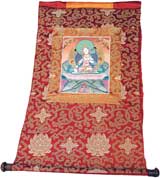Common Tibetan words and phrases

Tangkas are hung in Tibetan homes and are believed to protect and bless those who view them.
Butter Tea: Traditional Tibetan tea similar to the Darjeeling tea of India but made with yak butter. Butter tea is often made by elderly Tibetan women and served to young monks during meditation. It is also served at a Tibetan Monk’s initiation.
Chuba: A traditional kimono-like garment worn by both male and female Tibetans. The chuba is not worn by male Tibetans in India but has been modified for the female into a long dress with an undershirt and apron.
Karma Pa: The physical manifestation of the karma of the incarnations of the Buddha. Karma Pa literally means “movement of karma.” The current reincarnation of Karma Pa is the seventeenth Dahlia Lama.
Lama: The Tibetan term for a respected religious teacher, equivalent to the Sanskrit term guru. A lama is not necessarily a monk, though Chinese politicians use the term incorrectly to refer to any monk or reincarnate.
Mandala: A traditional form of meditation in which the Tibetan Buddhist monk spends hours in the creation of a religious depiction using only tiny grains of colored sand. When the creation is completed the monk sweeps the sand into the air in recognition of the impermanence of all things worldly.
Mantra: The recitation of a word or words with significant religious meaning. The mantra may be chanted, sung, thought or viewed by the Buddhist who uses it in meditation. Traditionally, the Tibetan mantra is Om Mani Padme Hum, a teaching of the Buddha that cannot be translated into a simple word or phrase in English.
Prayer Wheel: The traditional Tibetan tool of prayer, often a metal wheel on a wooden handle that spins, always to the right, to spread the thousands of mantras that are written in Tibetan script on a scroll of paper within the wheel.
Sidh Bar: The temple and monastery that houses the seventeenth reincarnation of Karma Pa, located in Northern India near Dharamsala and the temple that houses the Dalai Lama.
Stupa: A Buddhist monument used for meditation and worship that traditionally housed the relic of a holy person or site. The stupa today is less likely to hold a relic and more a symbolic altar for those who desire to quiet their minds and transcend to a state of meditation and communication.
Tangka: In Tibetan, the word “tangka” means silk, satin or cloth painting scroll. It is a traditional aid to meditation, hand-painted with interpretations of the Buddhist scripture.
Tangkas are hung in Tibetan homes and are believed to protect and bless those who view them.
Your donation will support the student journalists of Missouri Southern State University. Your contribution will allow us to purchase equipment and cover our annual website hosting costs.



























